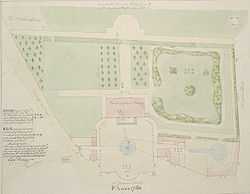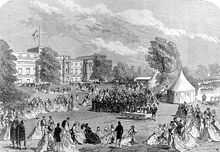Garden at Buckingham Palace
The garden at Buckingham Palace is situated at the rear (west) of Buckingham Palace. It covers much of the area of the former Goring Great Garden, named after Lord Goring, occupant of one of the earliest grand houses on the site. It was laid out by Henry Wise and subsequently redesigned by William Townsend Aiton for George IV.
The garden occupies a 42 acres (17 ha) site[1] in the City of Westminster, London and has two-and-a-half miles of gravel paths. Its area is bounded by Constitution Hill to the north, Hyde Park Corner to the west, Grosvenor Place to the south-west and the Royal Mews, Queen's Gallery, and Buckingham Palace to the south and east. The planting is varied and exotic, with a mulberry tree dating back to the time of James I of England.
Notable features include a large 19th-century lake which was once recently graced by a flock of flamingoes, and the Waterloo Vase. In the garden there is a summerhouse, a helicopter pad, and a tennis court.
Unlike the nearby Royal Parks of London, Buckingham Palace Garden is not usually open to the public. However when Buckingham Palace is open during August and September, visitors have access to part of the garden, which forms the exit from the palace at the end of the tour. (A large gift shop in a marquee is erected along the path at that time.) Visitors also have the opportunity to purchase specially made ice cream from the Buckingham Palace ice cream tent which is situated on the route out of the garden.
The garden is where the Queen's garden parties are held. In June 2002 she invited the public into the garden for entertainment for the first time during her reign. As part of her Golden Jubilee Weekend thousands of Britons were invited to apply for tickets to Party at the Palace where the guitarist Brian May of the band Queen performed his God Save the Queen guitar solo on top of Buckingham Palace. This concert was preceded the previous evening by a Prom at the Palace. During the Queen's 80th birthday celebrations in 2006 the garden was the scene of Children's Party at the Palace for an audience of 2,000 children.
Landscaping, lake and artworks

The landscape design was by Capability Brown but the garden was redesigned at the time of the palace rebuilding by William Townsend Aiton of Kew Gardens and John Nash. The great manmade lake was completed in 1828 and is supplied with water by the Serpentine Lake in Hyde Park.
According to Palace tourist guides, the garden is maintained by approximately eight full-time gardeners, with two or three part-timers. The trees include plane, Indian chestnut, silver maple, and a swamp cypress. In the south-west corner, there is a single surviving mulberry tree from the plantation installed by King James I of England when he unsuccessfully attempted to breed silkworms in the Mulberry Garden on the Buckingham Palace site. (This was not the site of today's garden; it was located closer to Green Park.)
Like the palace, the garden is rich in works of art. One of the most notable is the Waterloo Vase, the great urn commissioned by Napoleon to commemorate his expected victories, which in 1815 was presented unfinished to the Prince Regent. After the King had had the base completed by sculptor Richard Westmacott, intending it to be the focal point of the new Waterloo chamber at Windsor Castle, it was adjudged to be too heavy for any floor (at 15 ft (4.6 m) high and weighing 15 tons). The National Gallery, to whom it was presented, finally returned it in 1906 to the sovereign, Edward VII. King Edward then solved the problem by placing the vase outside in the garden where it now remains.
Also in the garden is a small summerhouse attributed to William Kent (circa 1740), a helicopter launching pad, and a tennis court where Björn Borg, John McEnroe and Steffi Graf have played.
The garden is regularly surveyed for its moths by staff from the Natural History Museum, and occasionally visited by the Queen's swans.
Garden parties

The garden is the setting for the many Royal garden parties held by the Queen each summer. However, guests, while numerous and from all stations in life, are usually those who hold a public position, or are in some way of national interest. In 2008, three parties were for nominated members of the public; and four parties for the Centenary of the Royal Charter to British Red Cross, the Territorial Army, the 'Not Forgotten' Association and for those attending the Lambeth Conference.
The guests take tea and sandwiches in marquees erected in the garden. As a military band plays the National Anthem, the Queen emerges from the Bow Room and slowly processes through the ranks of assembled guests towards her own private tea tent, greeting those previously selected for the honour.
Big Royal Dig
Buckingham Palace garden was one of three royal sites excavated over 25–28 August 2006 by the Time Team of archaeologists led by Tony Robinson. The results were televised, with some live streaming.
Timed to help celebrate the 80th birthday of Queen Elizabeth II, this marked Time Team's 150th dig. For the first time, the Queen gave permission for trenches to be dug in the grounds of Buckingham Palace, Windsor Castle, and the Palace of Holyroodhouse, Edinburgh. The Big Royal Dig is an example of the Queen opening up her homes for greater access to the public, as she did during her Golden Jubilee Weekend in 2002 and throughout 2006 for her 80th birthday.
The archaeologists had an unprecedented opportunity to probe the geophysics and history of three royal residences over a four-day period, with teams working concurrently in the three locations.
Henry Wise's ornamental canal for Buckingham House
Buckingham House, a precursor of the palace, was built in 1703 by the Duke of Buckingham. This graphic reconstruction shows Buckingham House from the garden side towards the West Front, i.e. looking at the rear of today's palace.
The archaeologists managed to uncover the original ornamental canal constructed by Henry Wise which ran westwards from the West Front of Buckingham House. (A surviving contemporary letter from the Duke of Buckingham to the Duke of Shrewsbury was instrumental in determining the canal's dimensions and thus the site for excavation.) The ornamental canal was the highlight of the garden, running straight down it, bordered by rows of trees. The parterre close to the house was flanked by formal gardens which continued as a row of trees bordering the canal. People sitting in the grandest rooms in the middle of the house would have enjoyed a most pleasing view.
The garden during the English Civil War
During the Civil War (1642-1651) London was Oliver Cromwell's Parliamentarian military centre, Royalist support for Charles I being based in Oxford. Goring Great Garden, as the garden was then, was the scene of defensive Parliamentarian earthworks – a situation whose irony Tony Robinson savoured, given the current Royal ownership. Anticipating some richly embarrassing finds, the television coverage featured a reenactment of a Roundhead (i.e., Republican) march on the great lawn.
Other finds
Robinson hoped to unearth evidence of Parliamentarian fortifications and a redoubt from the Civil War in the garden, but in the event, no trace of Civil War Parliamentarian defences was found. However, there were a number of 17th-century finds, including a possible button from Civil War uniform, a clay pipe, and a 17th-century trade token possibly from the pub The Swan on the Strand.
Additionally, evidence of the River Tyburn, which still runs below the Palace, was discovered. Other objects found included a diamond earring, dating to the Victorian era, and a 6,000-year-old Mesolithic flint blade.
See also
Notes
- ↑ "Buckingham Palace". Archived from the original on 2007-07-03. Retrieved 2007-07-10.
References
- Brown, Jane, and Christopher Simon Sykes. The Garden at Buckingham Palace: An Illustrated History. (London: Royal Collection, 2004.) ISBN 1-902163-82-6
- Nash, Roy. Buckingham Palace: The Place and the People. (London: Macdonald Futura Publishers, 1980.) ISBN 0-354-04529-6
External links
| Wikimedia Commons has media related to Garden at Buckingham Palace. |
- Royal Horticultural Society Article about the Gardens
- amazon.com DVD listing for edited live recording of Prom at the Palace ISBN B000069B68
- amazon.com DVD listing for edited live recording of Party at the Palace ISBN B000069003
- photographs from the Royal website of Children's Party at the Palace
- Channel4.com - Big Royal Dig
- Daily Telegraph article outlining main aims of the Buckingham Palace dig